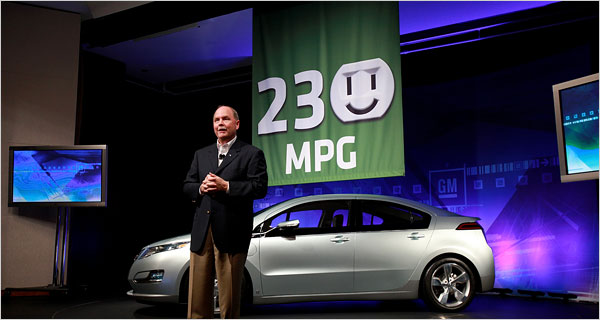
The NY Times story has one of the true glass-is-half-full headlines of our times:
G.M., Citing Progress, Reports Loss of $1.15 Billion
But these days, you take good news where you can find it, and the rest of the story is certainly a pleasant surprise:
General Motors, whose very survival was in doubt this year, is showing signs of life after its brief tour through bankruptcy this summer.G.M. said Monday that while it was still losing money, it had stabilized enough that it could take an important symbolic step and begin returning some of the $50 billion that the federal government provided to help give it a second chance.
The Obama administration said it was “encouraged” by G.M.’s initial performance since emerging from bankruptcy in July.
Others who had supported a G.M. bailout, despite widespread skepticism that the company’s problems were too big and numerous to fix, said G.M. had taken a big step toward a lasting recovery.
“The company is on its way to fulfilling its promise to American taxpayers,” said Representative John D. Dingell, Democrat of Michigan.
If GM can survive and thrive, it will certainly be one of the great corporate turnarounds of all time — and vindication for the taxpayer-funded bailout.
The company has a very long road ahead, though, and it will have to navigate a future that will increasingly favor more fuel efficient cars, as well as smaller cars and alternative fuel vehicles, particularly those with electric drives, because of a combination of peak oil, Obama’s deal to raise fuel economy standards, and growing domestic and global concern about global warming:
- Deutsche Bank: Oil to hit $175 a barrel by 2016, which “will drive a final stake into long-term oil demand,” spurred by a “disruptive technology” — “the hybrid and electric car, that will very likely have a far greater positive impact on oil efficiency than the market currently expects”
- World’s top energy economist warns peak oil threatens recovery, urges immediate action: “We have to leave oil before oil leaves us.”
- Obama will raise new car fuel efficiency standards to 35.5 mpg by 2015
So GM will have to be nimble and profitable in a car market that will become less and less like the one of the last few decades. Still, GM appears to be turning around even in these tough times:
G.M.’s results showed a healthier balance sheet, ample cash, and factory production much more in line with consumer demand — improvements it owes largely to the bankruptcy process, the helping hand of the federal government and a modest increase in car sales.
Even with that help, the nation’s largest automaker still lost nearly $1.2 billion in the third quarter.
But G.M.’s managers and directors have also made some fast decisions to help the company. They have shaken up the company’s famously bureaucratic culture. And they have used aggressive marketing, including a 60-day money-back guarantee, and some well-received new products, like the Cadillac SRX crossover, to bring shoppers back to showrooms.
As a result, even though G.M. has shed four of its brands, it has managed to hold onto roughly a fifth of the overall car market in the United States. The company is also generating cash now, rather than bleeding it.
That is why the company is in a position to begin paying back $6.7 billion in federal loans as soon as next month. “We think it’s important that we show the taxpayer we can repay this investment,” G.M.’s chief executive, Fritz Henderson, said Monday.
G.M. is still faring poorly compared to its cross-town rival, the Ford Motor Company, which earned a $1-billion profit in the third quarter without the benefit of any government assistance.
So here’s the question of the day: Will GM make it and pay back all of the taxpayers’ loans?


